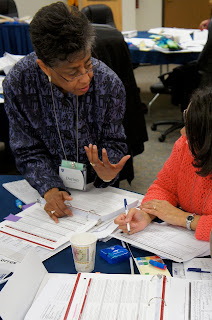| On Location! |
Opening comments by Dalia Zabala, AFT Educational Issues Department.
- History of this as an initiative that started way back in 2008.
- About 30 teachers were part of the original work team, many here today.
- In 2010, an ad-hoc committee was created to develop recommendations that would help guide the process.
- Take a close look at what the AFT has set forth as the 38 recommendations -- they include the categories of Standards Design, etc. from the recommendations.
- Goals for the session include innovation fund grant winners, linking national and state affiliates, and learning from each other.
My Reflection: What has been deemed 'college ready' by ACT has been meeting test score benchmarks -- for example, an 18 on the English text says that there is an 80 percent chance of succeeding in an average freshman composition class, or thereabouts. However, I've heard contradictory arguments that the stronger indicator of college preparedness is actually high school GPA.
Questions:
1. It seems to me the goal is here is to ramp up academics to the point at which a high school graduate is pretty much guaranteed to be prepared for post-secondary education or career training -- a gap that has been well-defined and is extremely costly. Some assessment companies seem to have locked down what it means to be ready, however. So, I'm wondering how can we maximize the efficacy of the new assessments to provide useful data to better inform our work?
2. Once there is a network of states with great P-20 data streams, doesn't it make sense to get more granular with the data and make a matrix / profile that would pull in all kinds of indicators, such as attendance, GPA, standardized test scores, new formative assessment scores, etc. to be able to gain a more helpful indicator for placement (not admission, as Ms. Gendron later made the contrast)? As a former adjunct community college instructor, I have seen first-hand how time and resources drain young people who struggle to get on track for college credit once "graduated" out of HS.
3. With #2, how are current classroom teacher leaders being tapped to help guide the feel for these needed new indicators, if a shoring up is seen to be the central concern of the CCSS -- increasing effectiveness of academic preparation? But can't we also square the circle and design useful tools to measure not only more precisely but more helpfully to get a true pulse of what's been loosely called "college readiness"?







